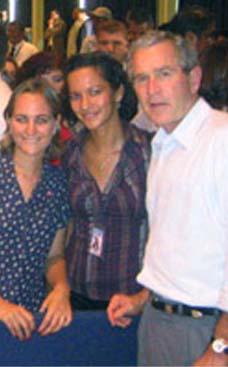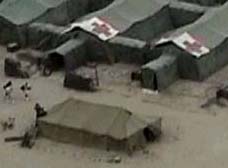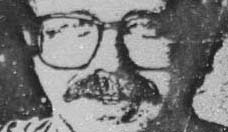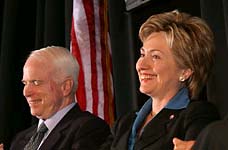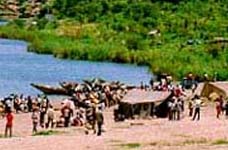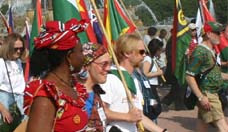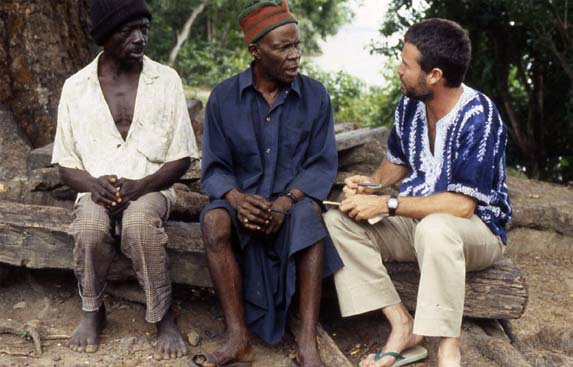
Opala’s joyous discovery linked 249 years of history, records and family ties from Sierra Leone in 1756 to modern-day South Carolina. The documents — ship records, plantation records and newspaper ads — allowed Opala to trace the roots of a family that started with a 10-year-old girl named Priscilla to a seventh-generation descendant in Charleston, S.C. Anthropologist Joseph Opala served as a Peace Corps Volunteer in Sierra Leone.
Joseph Opala Gathers 249 Years Of Documentation To Bring Seven Generations Together
Tracing A Slave’s Family History
Posted 2005-11-26
JMU Professor Gathers 249 Years Of Documentation To Bring Seven Generations Together
Caption: Joseph Opala interviewing an African elder living near Bunce Island (1988) Photo by Vera Viditz-Ward
By Jeff Casale
It was amid stacks of thousands of documents and records at the New-York Historical Society library that Joseph Opala found the connection.
In his hand was a document that showed the sale of slaves from Sierra Leone to plantation owners in South Carolina and Georgia. The handwritten docket was dated June 30, 1756.
Scrolling down the names, Opala came across one that caught his eye. "Elias Ball II: 3 boys, 2 girls."
"I whooped in that library," says Opala, a professor of African-American History and Studies at James Madison University.
Opala’s joyous discovery linked 249 years of history, records and family ties from Sierra Leone in 1756 to modern-day South Carolina. The documents — ship records, plantation records and newspaper ads — allowed Opala to trace the roots of a family that started with a 10-year-old girl named Priscilla to a seventh-generation descendant in Charleston, S.C.
"You’ve got a 249-year paper trail that has been unbroken from its African roots in Sierra Leone to South Carolina," says Opala, 55, lounging in a cushy chair at the Daily Grind in downtown Harrisonburg several months after his discovery. "It’s like a one in 1 million or one in 15 million chance that you would find something like this. This is a unique situation."
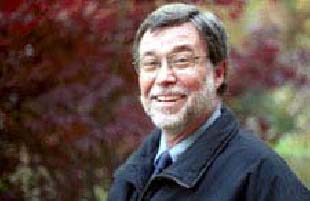
The documents that helped Opala during his research are on display in a new exhibit at the New-York Historical Society in New York. The exhibit, "Finding Priscilla’s Children: The Roots of American Slavery," opened earlier this month and will run through March as part of the society’s show, "Slavery in New York."
Getting Started
For 20 years, Opala has been searching for this connection, but he said his research objective didn’t always have this goal in mind.
Opala lived in Sierra Leone for 17 years, moving there after he joined the Peace Corps. In his 20s, Opala was a student of archaeology and anthropology, and that’s what he says he planned on studying when he got to the West African country.
Then somebody told him to check out Bance Island, a major slave-trading outpost on the Sierra Leone River between 1750 and 1800.
"I was resistant at first," Opala recalls. "I was already working my way around, finding stone tools, and I was all jazzed up, but then I was put on a boat to go out there."
What Opala found was an uninhabited island complete with jungle, monkeys and 40-foot brick walls. While the jungle and monkeys were expected, Opala didn’t know much about the fort that was built on Bance Island, now known as Bunce Island.
According to historical documents, as early as 1672 the Royal African Company of England established a fort on the island, but then abandoned it. Then in 1750, a London firm rebuilt the fort and established it as a slave market.
Opala says the slaves at this market were of particular interest to rice plantation owners in Georgia and South Carolina, because the slaves specialized in growing rice, a staple crop of the South.
"It was skilled labor," Opala says. "Sierra Leone was the ‘Rice Coast’ of West Africa, and South Carolina plantation owners realized they needed them. Rice plantations were famously rich. It was the first prominent American industry that was based on African-American know-how."
These slaves became known as the Gullah, an African heritage that still lives today on the coastlines of Georgia and South Carolina.
Homecoming
Priscilla was just 10 when she was put on the "Hare," a Newport, R.I., ship that traveled the African coast looking for slaves. Opala says he isn’t sure she boarded the boat at Bance Island, but he added that it was most likely.
Records from the ship’s captain discuss the number of slaves on the ship. These records tie with those left from the slave sale in Charleston, S.C., which shows that Ball bought five children off the ship, including a 10-year-old girl.
Then in Ball’s own records, which Opala found, the plantation owner notes the sale and that he named the child Priscilla.
"Slave ship records, records of the sale and plantation records — that’s five generations of documents, and you just don’t have that any more," Opala says. "Most slave ship records have not lasted over time."
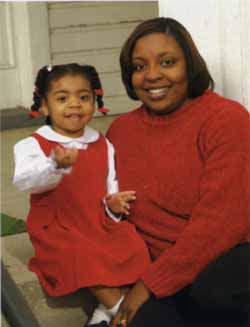
Caption: Mrs. Thomalind Martin Polite and her daughter Faith. Photo by Rick McKee/charlestonphotographer.com
After some digging and interviews, Opala and a colleague, Edward Ball, found a seventh-generation descendant of Priscilla — Mrs. Thomalind Martin Polite of Charleston, S.C. In May, Polite went with Opala to Sierra Leone. It was the first time that Polite had ever visited her ancestral home, and Opala said the homecoming was both spiritual and emotional. "When Sierra Leoneans spoke to her, they spoke to Mrs. Polite as though she were Priscilla," Opala said. "People spoke to the child inside her."
It was the bringing together of family nearly 250 years later.
Contact Jeff Casale at 574-6218 or jcasale@dnronline.com






